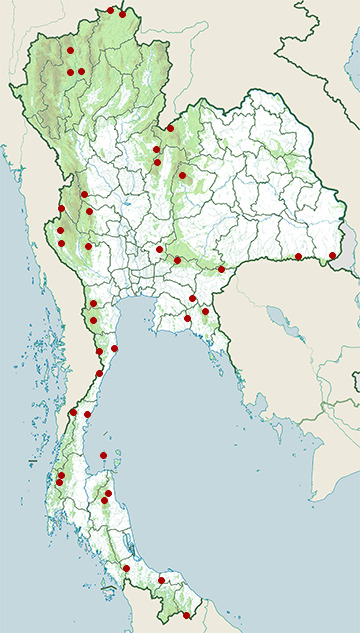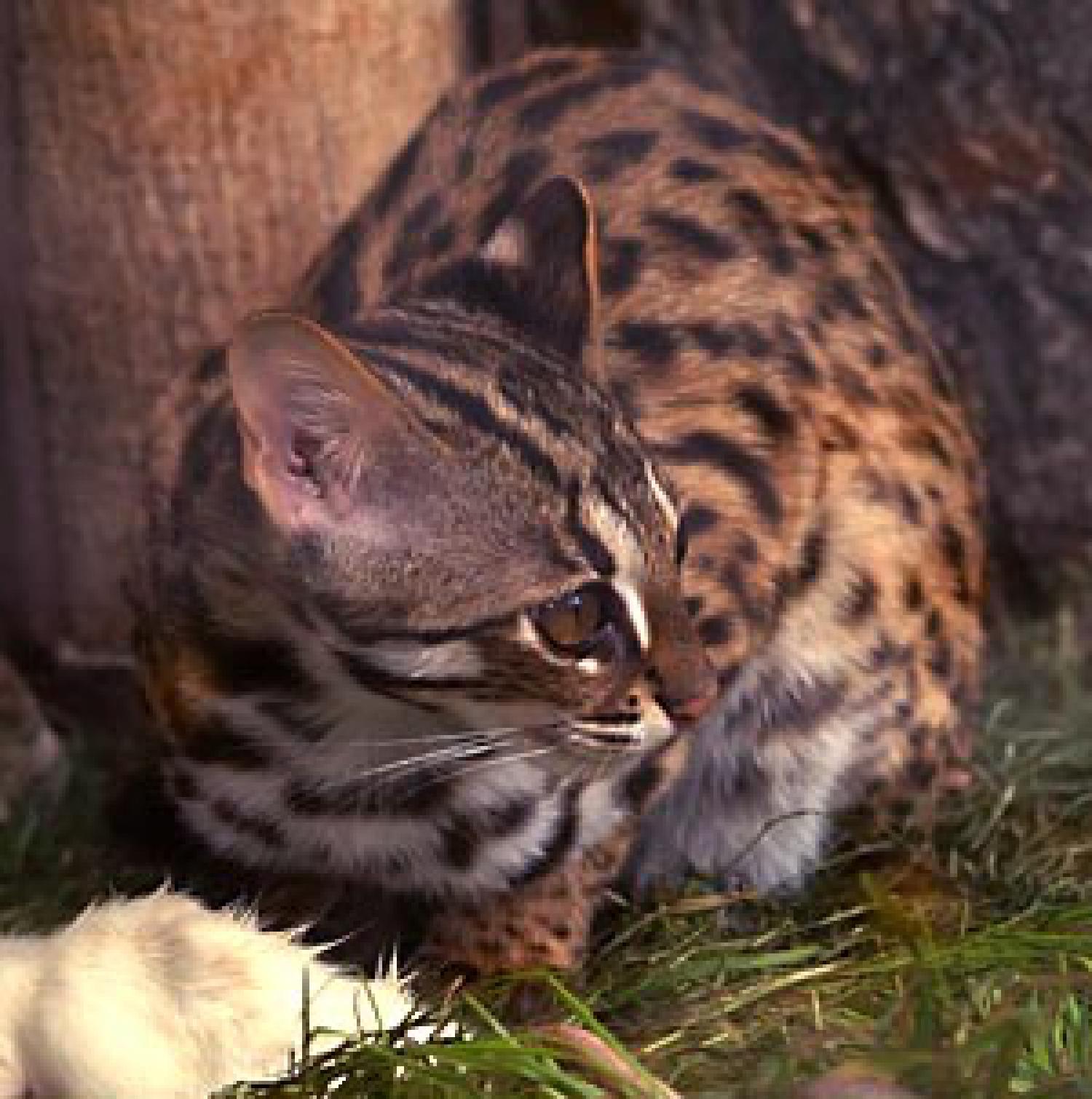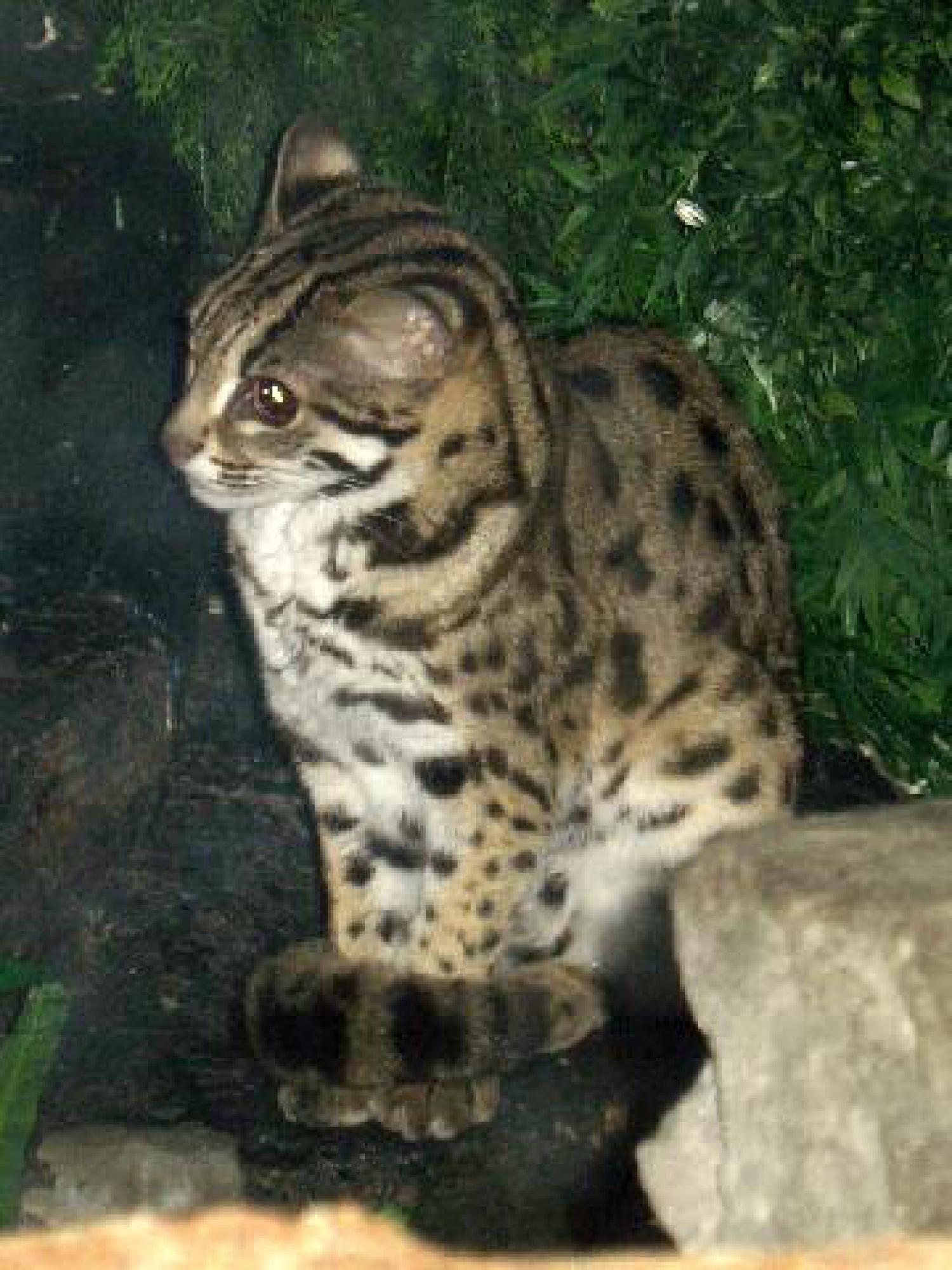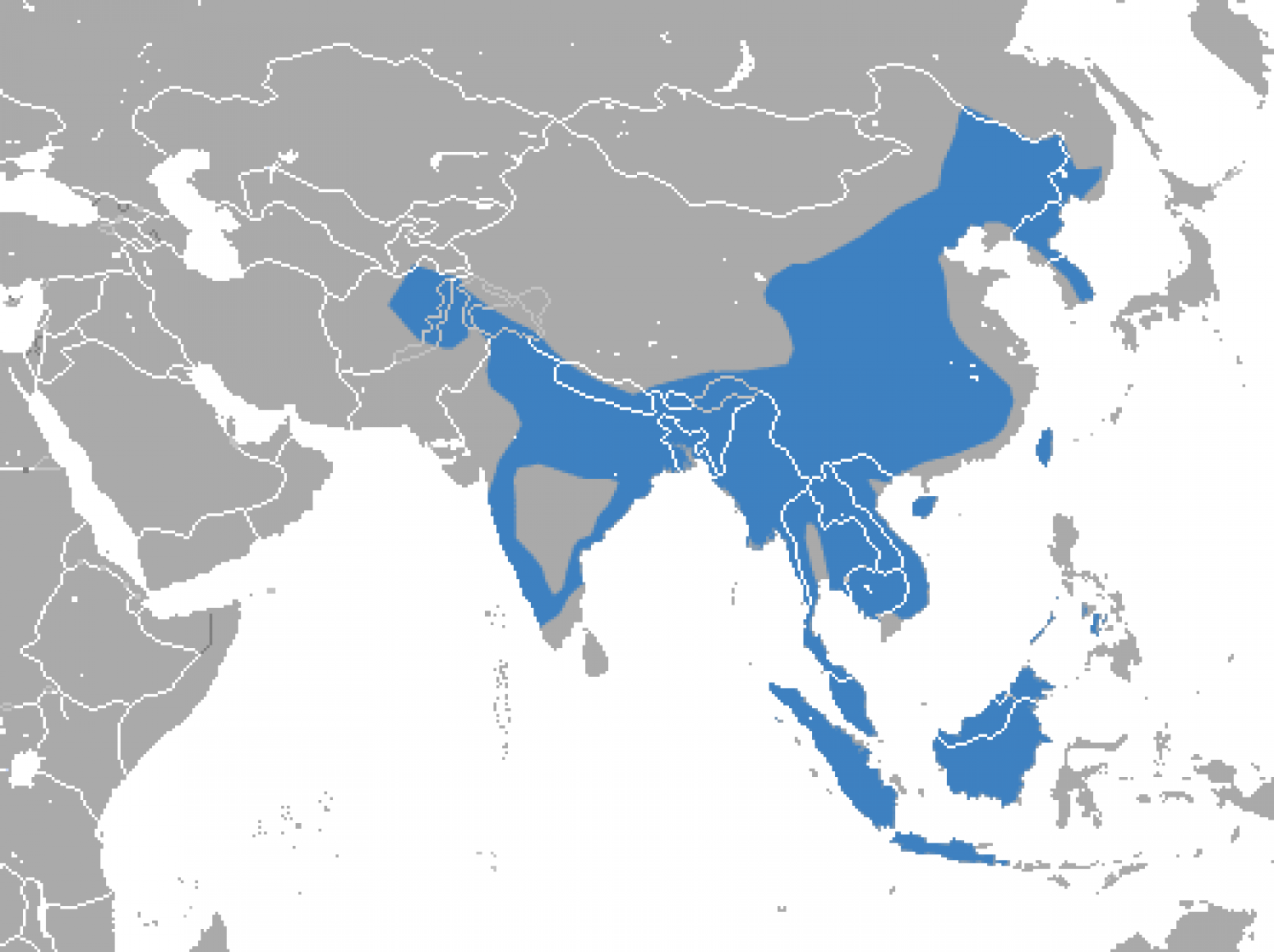Species of Thailand
Leopard cat
Prionailurus bengalensis
(Robert Kerr, 1792)
In Thai: แมวดาว
The leopard cat (Prionailurus bengalensis) is a small wild cat of South and East Asia. Since 2002 it has been listed as Least Concern by IUCN as it is widely distributed but threatened by habitat loss and hunting in parts of its range. There are twelve leopard cat subspecies, which differ widely in appearance.
The leopard cat's name is derived from the leopard-like spots prevalent in all subspecies, but its relation to the leopard is distant.
The leopard cat subspecies P. b. bengalensis is the wild foundation stock of a hybrid domestic cat breed, the Bengal cat.
Characteristics
A leopard cat is about the size of a domestic cat, but more slender, with longer legs and well-defined webs between its toes. Its small head is marked with two prominent dark stripes and a short and narrow white muzzle. There are two dark stripes running from the eyes to the ears, and smaller white streaks running from the eyes to the nose. The backs of its moderately long and rounded ears are black with central white spots. Body and limbs are marked with black spots of varying size and color, and along its back are two to four rows of elongated spots. The tail is about half the size of its head-body length and is spotted with a few indistinct rings near the black tip. The background color of the spotted fur is tawny, with a white chest and belly. However, in their huge range, they vary so much in coloration and size of spots as well as in body size and weight that initially they were thought to be several different species. The fur color is yellowish brown in the southern populations, but pale silver-grey in the northern ones. The black markings may be spotted, rosetted, or may even form dotted streaks, depending on subspecies. In the tropics, leopard cats weigh 0.55 to 3.8 kg, have head-body lengths of 38.8 to 66 cm, with long 17.2 to 31 cm tails. In northern China and Siberia, they weigh up to 7.1 kg, and have head-body lengths of up to 75 cm; generally, they put on weight before winter and become thinner until spring. Shoulder height is about 41 cm.
Distribution and habitat
Leopard cats are the most widely distributed Asian small cats. Their range extends from the
Amur region in the Russian Far East over the Korean Peninsula, China, Indochina, the Indian Subcontinent, to the West in northern Pakistan, and to the south in the Philippines and the Sunda islands of Indonesia. They are found in agriculturally used areas but prefer forested habitats. They live in tropical evergreen rainforests and plantations at sea level, in subtropical deciduous and coniferous forests in the foothills of the Himalayas at altitudes above 1000 m.
In 2009, a leopard cat was camera trapped in Nepal’s Makalu-Barun National Park at an altitude of 3254 m. At least six individuals inhabit the survey area, which is dominated by associations of rhododendron, oak and maple. The highest altitudinal record was obtained in September 2012 at 4500 m in the
Kanchenjunga Conservation Area.
In the northeast of their range they live close to rivers, valleys and in ravine forests, but avoid areas with more than 10 cm of snowfall. They are rare in Pakistan’s arid treeless areas. In Afghanistan, they were reported in the 1970s from Jalalkot and Norgul in the Kunar Valley, and the Waygul forest of Dare Pech.
In Sabah’s Tabin Wildlife Reserve leopard cats had average home ranges of 3.5 km2. In Thailand’s Phu Khieu Wildlife Reserve 20 leopard cats were radio-collared between 1999 and 2003. Home ranges of males ranged from 2.2 km2 to 28.9 km2, and of the six females from 4.4 km2 to 37.1 km2.
The Iriomote cat has been proposed as a species since 1967, but following mtDNA analysis in the 1990s it is now considered a subspecies of the leopard cat.
The Tsushima leopard cat lives exclusively on Tsushima Island. Initially regarded as belonging to the Chinese leopard cat subspecies, it is now considered an isolated population of the Amur leopard cat P. b. euptilurus/euptilura. The Japanese name for the Tsushima leopard cat is Tsushima Yamaneko.
Ecology and behavior
Leopard cats are , except during breeding season. Some are active during the day, but most hunt at night, preferring to stalk murids, tree shrews and hares. They are agile climbers and quite arboreal in their habits. They rest in trees, but also hide in dense thorny undergrowth on the ground. In the oil palm plantations of Sabah, they have been observed up to 4 m above ground hunting rodents and beetles. In this habitat, males had larger home ranges than females, averaging 3.5 km2 mi2 and 2.1 km2 mi2 respectively. Each male's range overlapped one or more female ranges.
Leopard cats can swim, but seldom do so. They produce a similar range of vocalisations to the domestic cat. Both sexes scent mark their territory by spraying urine, leaving faeces in exposed locations, head rubbing, and scratching.
Diet
Leopard cats are carnivorous, feeding on a variety of small prey including mammals, lizards, amphibians, birds and insects. In most parts of their range, small rodents such as rats and mice form the major part of their diet, which is often supplemented with grass, eggs, poultry, and aquatic prey. They are active hunters, dispatching their prey with a rapid pounce and bite. Unlike many other small cats, they do not "play" with their food, maintaining a tight grip with their claws until the animal is dead. This may be related to the relatively high proportion of birds in their diet, which are more likely to escape when released than are rodents.
Reproduction and development
There is no fixed breeding period in the southern part of its range; in the colder northern range they tend to breed around March or April, when the weather is mild enough to support newborn kittens. The estrus period lasts for 5–9 days. If the kittens do not survive, the female may come into heat again and have another litter that year.
After a gestation period of 60–70 days, two to four kittens are born in a den, where they remain until they are a month old. The kittens weigh about 75 to 130 g at birth and usually double their weight by age of two weeks; at five weeks, they are four times their birth weight. The eyes open at ten days, and the kittens start to eat solid food at 23 days. At the age of four weeks, the permanent canines appear, and the kittens begin to eat solid food. Leopard cats have lived for up to thirteen years in captivity.
Leopard cats usually pair for life and raise their kittens together for about 7 to 10 months. Full maturity is reached at 18 months, but in captivity, the male can become ready to breed at 7 months, and the female at 10 months.
Threats
In China, leopard cats are hunted mainly for their fur. Between 1984 and 1989, about 200, 000 skins were exported yearly. A survey carried out in 1989 among major fur traders revealed more than 800, 000 skins on stock. Since the European Union imposed an import ban in 1988, Japan has become the main buyer, and imported 50, 000 skins in 1989. Although commercial trade is much reduced, the species continues to be hunted throughout most of its range for fur, for food, and as pets. They are also widely viewed as poultry pests and killed in retribution.
In Myanmar, 483 body parts of at least 443 individuals were observed in four markets surveyed between 1991 and 2006. Numbers were significantly larger than non-threatened species. Three of the surveyed markets are situated on international borders with China and Thailand, and cater to international buyers, although the leopard cat is completely protected under Myanmar's national legislation. Effective implementation and enforcement of CITES is considered inadequate.
Conservation
Prionailurus bengalensis is listed in CITES Appendix II. In Hong Kong, the species is protected under the Wild Animals Protection Ordinance Cap 170. The population is well over 50, 000 individuals and, although declining, the cat is not endangered.
The Tsushima leopard cat is listed as Critically Endangered on the Japanese Red List of Endangered Species, and has been the focus of a conservation program funded by the Japanese government since 1995.
Taxonomic history
In 1792, Robert Kerr first described a leopard cat under the binominal Felis bengalensis in his translation of Carl von Linné’s Systema Naturae as being native to southern Bengal. Between 1829 and 1922, different authors of 20 more descriptions classified the cat either as Felis or Leopardus. Owing to the individual variation in fur colour, leopard cats from British India were described as Felis nipalensis from Nepal, Leopardus ellioti from the area of Bombay, Felis wagati and Felis tenasserimensis from Tenasserim. In 1939, Reginald Innes Pocock subordinated them to the genus Prionailurus. The collection of the Natural History Museum in London comprised several skulls and large amounts of skins of leopard cats from various regions. Based on this broad variety of skins, he proposed to differentiate between a southern subspecies Prionailurus bengalensis bengalensis from warmer latitudes to the west and east of the Bay of Bengal, and a northern Prionailurus bengalensis horsfieldi from the Himalayas, having a fuller winter coat than the southern. His description of leopard cats from the areas of Gilgit and Karachi under the trinomen Prionailurus bengalensis trevelyani is based on seven skins that had longer, paler and more greyish fur than those from the Himalayas. He assumed that trevelyani inhabits more rocky, less forested habitats than bengalensis and horsfieldi.
Between 1837 and 1930, skins and skulls from China were described as Felis chinensis, Leopardus reevesii, Felis scripta, Felis microtis, decolorata, ricketti, ingrami, anastasiae and sinensis, and later grouped under the trinomen Felis bengalensis chinensis. In the beginning of the 20th century, a British explorer collected wild cat skins on the island of Tsushima. Oldfield Thomas classified these as Felis microtis, which had been first described by Henri Milne-Edwards in 1872.
Two skins from Siberia motivated Daniel Giraud Elliot to write a detailed description of Felis euptilura in 1871. One was depicted in Gustav Radde’s illustration cum description of a wild cat; the other was part of a collection at the Regent's Park Zoo. The ground colour of both was light brownish-yellow, strongly mixed with grey and covered with reddish-brown spots, head grey with a dark-red stripe across the cheek. In 1922, Tamezo Mori described a similar but lighter grey spotted skin of a wild cat from the vicinity of Mukden in Manchuria that he named Felis manchurica. Later both were grouped under the trinomen Felis bengalensis euptilura. In the 1970s and 1980s, the Russian zoologists Geptner, Gromov and Baranova disagreed with this classification. They emphasized the differences of skins and skulls at their disposal and the ones originating in Southeast Asia, and coined the term Amur forest cat, which they regarded as a distinct species. In 1987, Chinese zoologists pointed out the affinity of leopard cats from northern China, Amur cats and leopard cats from southern latitudes. In view of the morphological similarities they did not support classifying the Amur cat as a species.
The initial binomial euptilura given by Elliott was eventually changed to euptilurus referring to the ICZN Principle of Gender Agreement; at present, both terms are used.
Molecular analysis of 39 leopard cat tissue samples clearly showed three clades: a Northern Lineage and Southern Lineages 1 and 2. The Northern Lineage comprised leopard cats from Tsushima Islands, the Korean Peninsular, the continental Far East, Taiwan, and Iriomote Island. Southern Lineage 1, comprising Southeast Asian populations, showed higher genetic diversity. Southern Lineage 2 has large genetic distances from other lineages.
Leopard cat and hybrids as pets
In the USA, P. bengalensis is listed as endangered under the Endangered Species Act since 1976; except under permit, it is prohibited to import, export, sell, purchase and transport the felid in interstate commerce.
Keeping a leopard cat as a pet requires a license in most places. License requirements vary by location.
The Asian leopard cat (P. b. bengalensis) is mated with a domestic cat to produce hybrid offspring known as the Bengal cat. This hybrid is usually permitted to be kept as pet without a license. For the typical pet owner, a Bengal cat should be at least four generations (F4) removed from the leopard cat. The "foundation cats" from the first three filial generations of breeding (F1–F3) are usually reserved for breeding purposes or the specialty-pet home environment.
This article uses material from Wikipedia released under the Creative Commons Attribution-Share-Alike Licence 3.0. Eventual photos shown in this page may or may not be from Wikipedia, please see the license details for photos in photo by-lines.
Scientific classification
- Kingdom
- Animalia
- Phylum
- Chordata
- Class
- Mammalia
- Order
- Carnivora
- Family
- Felidae
- Genus
- Prionailurus
- Species
- Prionailurus bengalensis
Common names
- German:
- Bengalkatze
- Leopardkatze
- English:
- Leopard cat
- Mainland leopard cat
- Common leopard cat
- Spanish:
- Gato Bengalí
- Gato de Bengala
- French:
- Chat de Chine
- Chat-léopard Du Bengale
- Italian: Gatto leopardo
- Dutch: Bengaalse tijgerkat
- Russian:
- Бенгальская кошка
- ка́рликовая ко́шка
- дальневосто́чный кот
- Swedish: Leopardkatt
- Thai: แมวดาว
Subspecies
Prionailurus bengalensis alleni, Henri Jacob Victor Sody, 1949
Range: Hainan Island
Prionailurus bengalensis bengalensis, Robert Kerr, 1792
Range: India, Bangladesh, Myanmar, Thailand, the Malay Peninsula to Indochina and Yunnan in China
Prionailurus bengalensis borneoensis, Brongersma, 1936
Range: Borneo
Prionailurus bengalensis chinensis, Gray, 1837
Range: Taiwan and China except Yunnan
Prionailurus bengalensis euptilurus/euptilura, Daniel Giraud Elliot, 1871
Common name: Amur leopard cat
Range: Eastern Siberia, Manchuria, Korea and on the Tsushima Island;
Prionailurus bengalensis heaneyi, Colin Peter Groves, 1997
Range: Philippine island of Palawan
Prionailurus bengalensis horsfieldi, Gray, 1842
Range: Kashmir, Punjab, Kumaon, Nepal, Sikkim and Bhutan
Prionailurus bengalensis iriomotensis, Yoshinori Imaizumi, 1967
Common name: Iriomote cat
Range: Found exclusively on the tiny island of Iriomote, one of the Ryukyu Islands in the Japanese Archipelago;
Prionailurus bengalensis javanensis, Anselme Gaëtan Desmarest, 1816
Range: Java and Bali;
Prionailurus bengalensis rabori, Colin Peter Groves, 1997
Common name: Visayan leopard cat
Range: Philippine islands of Negros, Cebu and Panay.
Prionailurus bengalensis sumatranus, Thomas Horsfield, 1821
Range: Sumatra and Tebingtinggi
Prionailurus bengalensis trevelyani, Reginald Innes Pocock, 1939
Range: Northern Kashmir and Punjab and in southern Baluchistan
Conservation status

Least Concern (IUCN3.1)
Photos
Please help us review our species pages if wrong photos are used or any other details in the page is wrong. We can be reached via our contact us page.
Range Map

- Ang Thong National Marine Park
- Chaloem Rattanakosin National Park
- Chiang Dao Wildlife Sanctuary
- Chiang Saen District, Chiang Rai
- Doi Saket District, Chiang Mai
- Doi Suthep - Pui National Park
- Doi Tung
- Hala-Bala Wildlife Sanctuary
- Huai Kha Khaeng Wildlife Sanctuary
- Huai Yang Waterfall National Park
- Kaeng Khoi District, Saraburi
- Kaeng Krachan National Park
- Khao Ang Rue Nai Wildlife Sanctuary
- Khao Chamao - Khao Wong National Park
- Khao Dinsor (Chumphon Raptor Center)
- Khao Kho District, Phetchabun
- Khao Laem National Park
- Khao Luang National Park
- Khao Nan National Park
- Khao Sam Roi Yot National Park
- Khao Soi Dao Wildlife Sanctuary
- Khao Sok National Park
- Khao Yai National Park
- Khlong Saeng Wildlife Sanctuary
- Kui Buri National Park
- Mae Nam Phachi Wildlife Sanctuary
- Mae Wong National Park
- Namtok Sai Khao National Park
- Phanom Dong Rak Wildlife Sanctuary
- Phu Chong Na Yoi National Park
- Phu Hin Rong Kla National Park
- Phu Khiao Wildlife Sanctuary
- Phu Ruea National Park
- Sadeth Naikrom - Krom Luang Wildlife Sanctuary
- Ta Phraya National Park
- Thong Pha Phum District, Kanchanaburi
- Thung Yai Naresuan Wildlife Sanctuary
- Ton Nga-Chang Wildlife Sanctuary


